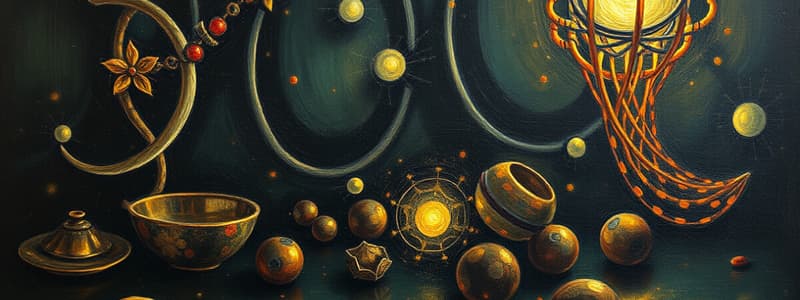Podcast
Questions and Answers
What is the primary concept introduced by atomic theory regarding the composition of matter?
What is the primary concept introduced by atomic theory regarding the composition of matter?
- Matter is made up of electrons only.
- All matter is composed of molecules.
- Matter can exist in different phases without atoms.
- All matter is composed of atoms. (correct)
Which type of particle within an atom carries a positive electrical charge?
Which type of particle within an atom carries a positive electrical charge?
- Proton (correct)
- Atomic mass unit
- Neutron
- Electron
What does the atomic number of an element signify?
What does the atomic number of an element signify?
- The combined number of protons and neutrons.
- The number of protons in the atom. (correct)
- The total mass of the atom.
- The number of neutrons in the nucleus.
Which of the following statements about subatomic particles is correct?
Which of the following statements about subatomic particles is correct?
What best describes the structure of an atom?
What best describes the structure of an atom?
How do opposite electrical charges interact in an atom?
How do opposite electrical charges interact in an atom?
Which of the following statements about chemical reactions is true according to atomic theory?
Which of the following statements about chemical reactions is true according to atomic theory?
Isotopes of an element differ in which of the following properties?
Isotopes of an element differ in which of the following properties?
What is the mass number (A) of phosphorus if its atomic number (Z) is 15 and it has 16 neutrons?
What is the mass number (A) of phosphorus if its atomic number (Z) is 15 and it has 16 neutrons?
How many neutrons are present in a silver atom with a mass number (A) of 109 and atomic number (Z) of 47?
How many neutrons are present in a silver atom with a mass number (A) of 109 and atomic number (Z) of 47?
Which of the following statements about isotopes is true?
Which of the following statements about isotopes is true?
If an atom has 28 protons and a mass number (A) of 60, how many electrons does it have when it is neutral?
If an atom has 28 protons and a mass number (A) of 60, how many electrons does it have when it is neutral?
What is the correct representation of the isotope tritium?
What is the correct representation of the isotope tritium?
Which of the following pairs is an example of isotopes?
Which of the following pairs is an example of isotopes?
What does the atomic number (Z) of an element represent?
What does the atomic number (Z) of an element represent?
What is the number of neutrons in chlorine-37?
What is the number of neutrons in chlorine-37?
What is the atomic weight of an element based on?
What is the atomic weight of an element based on?
Which isotope is noted for being used in nuclear reactors?
Which isotope is noted for being used in nuclear reactors?
What characteristic defines metals in the periodic table?
What characteristic defines metals in the periodic table?
How was the modern periodic table first conceptualized?
How was the modern periodic table first conceptualized?
In the context of gallium, which percentage corresponds to the isotope Ga-69?
In the context of gallium, which percentage corresponds to the isotope Ga-69?
If an element X has a mass number of 194 and 78 neutrons, how many protons does it have?
If an element X has a mass number of 194 and 78 neutrons, how many protons does it have?
What defines a nonmetal in the periodic table?
What defines a nonmetal in the periodic table?
What is the significance of isotopic abundance in calculating atomic weight?
What is the significance of isotopic abundance in calculating atomic weight?
Flashcards are hidden until you start studying
Study Notes
Atomic Theory and the Structure of Atoms
- Atoms are the smallest particles of an element that retain its identity, originating from the Greek word "atomos," meaning indivisible.
- The atomic theory consists of four key assumptions:
- All matter is made up of atoms.
- Atoms of a specific element differ from those of all other elements.
- Chemical compounds form from atoms in fixed ratios, combining only whole atoms.
- Chemical reactions involve rearranging atoms, not changing their identities.
- Atoms comprise protons (positive charge), neutrons (neutral), and electrons (negative charge).
- The mass of subatomic particles is measured in atomic mass units (amu), based on a carbon-12 atom.
- Atoms predominantly consist of empty space, with a dense nucleus formed by protons and neutrons, surrounded by rapidly moving electrons.
- The nucleus's size is extremely small compared to the entire atom, analogous to a pea in a baseball stadium.
Elements and Atomic Number
- The atomic number (Z) indicates the number of protons in an atom, unique to each element.
- The mass number (A) is the sum of protons and neutrons within an atom.
- The relationship is defined as:
- Number of neutrons = Mass number (A) - Atomic number (Z).
- Atoms maintain electrical neutrality when the number of protons equals the number of electrons.
- Example: Sodium (Na) has 11 protons and an atomic number of 11, while Magnesium (Mg) has 12 protons with an atomic number of 12.
- Phosphorus (P) with atomic number 15 has 15 protons, with a mass number of 31, indicating it has 16 neutrons.
Isotopes and Atomic Weight
- Isotopes are atoms with the same atomic number (protons) but different mass numbers (neutrons).
- Examples include Chlorine-35 and Chlorine-37, both having 17 protons but differing neutron counts (18 and 20, respectively).
- Isotopes are indicated by their mass number as a superscript and atomic number as a subscript in front of the element symbol.
- Most elements exist as a mixture of isotopes, and atomic weight is the weighted average mass of an element's isotopes, factoring in their natural abundance.
- Atomic weight is calculated using individual isotope masses and their relative percentages.
The Periodic Table
- The periodic table organizes all known elements by atomic symbol, name, and atomic mass in a grid format.
- Dmitri Mendeleev created an early version of the periodic table, categorizing elements by physical properties and chemical behaviors.
- Elements can be classified as:
- Metals: Malleable, lustrous, good conductors of heat and electricity, primarily found on the left side of the table (e.g., Sodium, Magnesium).
- Nonmetals: Poor conductors of heat and electricity, located on the upper-right side of the table.
Studying That Suits You
Use AI to generate personalized quizzes and flashcards to suit your learning preferences.



